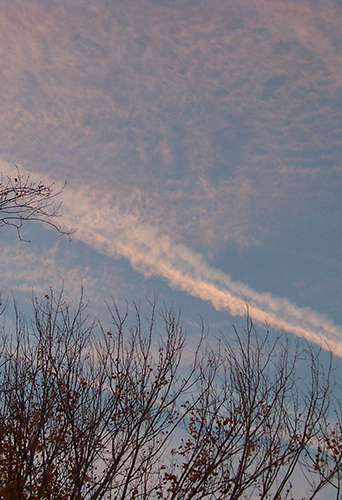
Contrails at sunset display the distinct color change between the upper contrail and the natural cirrus clouds. Photo by Lin Chambers, southeastern Virginia, November 2003. LARC NASA.gom
Despite their benign look, the thin visible clouds that follow in the path of jet airliners directly contribute to global warming. The United Nations Intergovernmental Panel on Climate Change (IPCC) estimates that these aviation-induced clouds contribute 2 percent of the earth’s total anthropogenic (human-made) global warming.
“By taking actions to avoid the creation of contrails, the air transportation system can reduce the anthropogenic (i.e. human-made) warming,” explains associate professor Lance Sherry, director of the Center for Air Transportation Systems Research (CATSR) and associate professor in the Department of Systems Engineering and Operations Research (SEOR). “Unlike carbon dioxide that remains in the atmosphere for decades and affects climate change 20 years from the date of emission, avoiding contrails can reduce aviation-induced global warming today. This can buy society time for other carbon dioxide reduction initiatives to take effect.”
When jets burn fuel, they emit water along with soot particles. Under specific atmospheric conditions--– high humidity and low temperatures--– the water freezes and bonds to the soot to form ice crystals.
The ice crystals in the clouds reflect incoming radiation from the sun and reflect outgoing radiation from the earth. In this way, these aviation-induced clouds trap radiation in the atmosphere, resulting in a warming effect.
Recent research by Denis Avila, PhD ‘19 used big data analytics to analyze weather patterns and flight trajectories over the United States. Avila’s work showed that less than 25 percent of the total daily flights generate significant contrails. These contrails typically are located in the Southeast and on the West coast and occur three times more frequently in the summer than the winter months.
For the flights that are forecast to generate contrails, simply flying 2,000 feet higher than usual would reduce the radiative effect of contrails by 63 percent.
SEOR and CATSR teams continue to research along multiple research threads. One team is looking at the use of jet fuel additives to modify the properties of the ice crystals so that they trap less radiation. Another team is investigating the effects of the ambient background atmospheric composition (e.g. percent of sea-salt in the atmosphere) on the reflective properties of the ice crystals in the aviation-induced clouds.
Yet another research thread is tasked to develop the algorithms that could be used by airlines and air traffic control to avoid contrails and to develop incentives for airlines to voluntarily take the higher contrail-free cruise flight levels.
“This research really showcases the multi-disciplinary nature of System Engineering and Operations Research. The creativity and tenacity of this research group is a testament to the quality of the high impact research being conducted by the department.”
John Shortle, SEOR department chair
